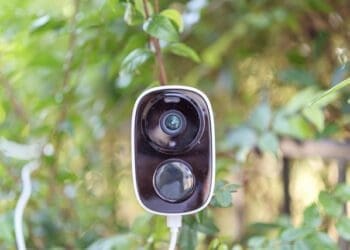In today’s world, we’re constantly looking for ways to make our homes smarter and safer. Home security systems have come a long way, now integrating seamlessly with our smart home devices to provide peace of mind and convenience. We’ve seen a surge in smart home accessories that not only protect our property but also enhance our daily lives. From video doorbells to security cameras and motion sensors, these technologies are transforming how we monitor and secure our homes.
We’ll explore how to choose the best home security systems for smart homes, taking into account your specific needs and the latest innovations in the field. We’ll compare top smart home security options, discuss key features to look for, and help you understand how these systems can work with your existing smart home setup. Whether you’re considering professional monitoring or a DIY approach, we’ll guide you through the process of selecting the right equipment and cameras to create a comprehensive security solution for your smart home.
Assess Your Smart Home Security Needs

When we’re looking to secure our smart homes, the first step is to assess our specific security needs. This process involves evaluating our property, identifying vulnerable areas, and considering our lifestyle. Let’s break it down:
Evaluate Your Property
To start, we need to take a comprehensive look at our property. We should begin with a perimeter walk-around, carefully examining our fences, gates, and outdoor barriers for integrity. It’s crucial to scrutinize windows, external doors, and additional structures like sheds and garages to ensure they can withstand unauthorized entry attempts .
Take advantage of new articles, click here.
We shouldn’t overlook the role of landscaping and outdoor lighting in our security assessment. These elements can either enhance our security or create weaknesses if not properly managed. Proper lighting, for instance, can deter potential intruders by eliminating hiding spots.
Identify Vulnerable Areas
Next, we need to identify the areas of our home that are most susceptible to break-ins and intrusions. Ground-level entry points are typically the primary targets for burglars . These include:
- Front doors: As the main entry point for homeowners and guests, front doors are particularly vulnerable. Burglars may attempt forced entry through weak locks or compromised door frames.
- Back doors: These are popular targets, especially if they’re hidden from view. Sliding glass doors can be particularly susceptible if not properly secured.
- First-floor windows: These are attractive entry points due to their accessibility and potential lack of security measures.
- Garages: These can pose risks, especially if they have direct access to the home. A compromised garage door or inadequate security measures can provide intruders with an opportunity to enter the property undetected.
It’s critical to evaluate the effectiveness of our door and window locks, understand the risks associated with sliding doors, and consider the security of basements, attics, and utility entry points . Each type of lock and entryway has its considerations for maximizing safety.
We should also pay attention to points of entry that are less visible from the street or neighboring properties, as these can be attractive to burglars due to the lower chance of being noticed .
Consider Your Lifestyle
Our daily routines and patterns can significantly impact our home’s security. Work schedules and vacation times, for instance, can make our homes more susceptible to breaches . We need to be aware of these patterns and consider how they might affect our security needs.
Another crucial factor to consider is our budget for a smart home security system. We need to think about how much we’re willing to invest in the initial setup as well as any ongoing monitoring fees. Our budget will influence the features and technologies we can incorporate into our system, so it’s important to strike a balance between affordability and the level of security we desire .
When assessing our security needs, we should also consider the convenience factor. Smart home security systems offer features that not only protect our property but also enhance our daily lives. For example, we might want a system that allows us to monitor and control our security remotely via smartphones or tablets. These systems often include features such as live video streaming, motion detection, and automated alerts, which are ideal for tech-savvy homeowners who prefer a hands-on approach to home security .
By thoroughly assessing our smart home security needs, we can make informed decisions about the type of system that will best protect our property and provide peace of mind. Remember, investing in a home security system is not just about protection; it’s also a strategic move to enhance our property’s value. From access to potential insurance discounts to deterring burglars and appealing to modern buyers, the benefits are clear .
Having fun with this context. I have other articles about this topic. Discover more!!!!!
Compare Top Smart Home Security Systems

When we’re looking to secure our smart homes, it’s essential to compare the top systems available. Let’s take a closer look at some of the leading options in the market:
ADT
ADT is one of the most established names in home security, with a history dating back to the telegraph era . They offer a comprehensive range of security equipment, including door and window sensors, smart locks, doorbell cameras, and connected thermostats . While ADT’s pricing is on the higher side, they provide a white-glove customer service experience and excellent mobile and web app interfaces .
One of ADT’s unique features is its network of nine monitoring facilities, ensuring continuous service even if some facilities shut down . However, ADT does require long-term contracts, typically three years (two in California), which may be a drawback for some homeowners .
Vivint
Vivint is a relatively newer player in the market but has quickly made a name for itself with its technological edge . They offer state-of-the-art home security systems with smart home features, making them an excellent choice for tech-savvy users .
Vivint’s starter package includes a touchscreen and a couple of sensors, but what sets them apart is their wide range of third-party device integrations . This flexibility allows us to add compatible smart garage doors, video doorbells, or security cameras on our own terms and timing .
While Vivint’s equipment can be pricey, they offer free installation during promotional periods . Their monitoring plans range from $49.99 to $59.99 per month, depending on the number of cameras .
SimpliSafe
SimpliSafe is an excellent option for those of us who prefer a DIY approach. Their system is easy to install and use, offering a comprehensive set of features including security cameras and battery-powered motion detection sensors .
One of SimpliSafe’s strengths is its affordability. Starter kits begin at $250, and we can build a custom alarm system with the exact mix of devices we need . Their monitoring plans start at $10 a month, but for the best features, we’d recommend the $30-a-month professional monitoring service plan .
SimpliSafe has consistently received high marks for customer satisfaction, ranking as the top DIY home security system in J.D. Power’s 2020 home security satisfaction study .
Ring Alarm
Ring, now owned by Amazon, offers excellent home security packages for those of us who like to take control of our setup . Their eight-piece starter kit includes four sensors, a base station, a keypad, a motion detector, and a range extender .
One of Ring’s standout features is its built-in Wi-Fi 6 mesh router in the Alarm Pro model, which provides excellent power and internet backup solutions . Ring also supports Alexa voice control and works with numerous Ring and third-party devices .
Ring’s pricing is competitive, with professional monitoring available for $20 per month without requiring a contract . However, it’s worth noting that Ring lacks support for Google Assistant, HomeKit, and IFTTT .
In conclusion, each of these systems has its strengths. ADT offers reliability and extensive experience, Vivint provides cutting-edge technology and flexibility, SimpliSafe excels in DIY simplicity and affordability, while Ring offers great integration with Amazon’s ecosystem. The best choice for us will depend on our specific needs, budget, and preferences for smart home integration.
Key Features to Look for in Smart Security Systems
When we’re in the market for a smart home security system, there are several key features we should consider to ensure we’re getting the best protection and convenience. Let’s explore some of these essential features that can make a significant difference in our home security setup.
Smart Home Integration
One of the most important features to look for is smart home integration. We want our security system to seamlessly connect with other smart devices in our home, such as lights, thermostats, and appliances. This integration allows us to control and monitor our entire home from a single app or interface, making our lives more convenient and our homes more secure .
For example, ADT partners with Google and offers the complete line of Nest products, including Nest hubs, cameras, and thermostats. This partnership allows us to arm and disarm our system using voice commands and control devices like smart locks, lights, and plugs . Similarly, Vivint works seamlessly with both Google Home and Alexa, and its Z-wave compatibility lets us link virtually any smart device to our system .
Professional Monitoring Options
Another crucial feature to consider is professional monitoring. With this option, our security system is connected to a 24/7 monitoring center that can dispatch emergency services if an alarm is triggered. This provides an extra layer of protection and peace of mind, especially when we’re away from home .
Many smart security systems offer flexible monitoring options. For instance, SimpliSafe allows us to choose between self-monitoring and professional monitoring, giving us the freedom to decide what works best for our needs and budget .
Mobile App Control
A user-friendly mobile app is a must-have feature for any smart security system. It allows us to arm and disarm the system, view camera footage, and receive alerts from our smartphone or tablet. This remote access is particularly useful for checking in on our home while we’re away .
The quality of the mobile app can significantly impact our experience with the security system. For example, the ADT Control app is praised for its seamless operation and user-friendly interface. It makes it easy to control smart devices and create “Scenes” (scheduled chains of smart device events) without feeling intimidated .
AI-Powered Cameras
Artificial Intelligence (AI) has revolutionized home security cameras, making them smarter and more efficient. AI-powered cameras use advanced computer vision and machine learning algorithms to detect and identify people, vehicles, and other objects of interest. This technology can provide more accurate alerts and reduce false alarms .
For instance, the Arlo Pro 3 stands out with its ability to detect not just people, but also packages, animals, and vehicles. This variety in detection capabilities makes it a top choice among AI-powered security cameras .
Some cameras, like the Nest Cam IQ Indoor, go a step further by offering person detection and familiar face alerts. This means we can receive notifications specifically when a family member arrives home or when an unfamiliar face is detected .
When choosing a smart home security system, we should look for these key features to ensure we’re getting a comprehensive, user-friendly, and technologically advanced solution. By considering smart home integration, professional monitoring options, mobile app control, and AI-powered cameras, we can create a security setup that not only protects our home but also enhances our daily lives.
Conclusion
The journey to secure our smart homes is an exciting one, filled with cutting-edge technology and endless possibilities. By carefully assessing our needs, comparing top systems, and focusing on key features, we can create a tailored security solution that not only protects our property but also enhances our daily lives. The right smart home security system has the power to give us peace of mind and make our homes more efficient.
As we move forward in this ever-evolving landscape of home security, it’s crucial to stay informed about new developments and innovations. The future of smart home security looks bright, with AI and advanced integration leading the way. By choosing a system that aligns with our lifestyle and adapts to new technologies, we can ensure our homes remain safe and smart for years to come.
FAQs
1. Which companies offer the best smart home security systems?
Several companies are recognized for their excellence in smart home security systems:
- ADT: Offers the best smart home security app.
- Vivint: Known for its 24/7 monitoring services.
- SimpliSafe: Compatible with Google Home.
- abode: Ideal for DIY enthusiasts.
- Ring Alarm: Works well with Alexa.
- Cove: Noted for its ease of use.
2. How should I go about selecting an appropriate home security system?
When choosing a home security system, consider the following factors:
- Installation: Decide between professional or DIY installation.
- Costs: Evaluate the upfront and ongoing costs.
- Contract Requirements: Understand the terms and duration of the contract.
- Monitoring Options: Look at the different monitoring services available.
- Smart Home Integration: Ensure compatibility with existing smart home devices.
- Equipment Type: Consider the types of sensors and technology offered.
- Connection Type: Check whether the system uses Wi-Fi, cellular, or landline connections.
3. What are the top five home security systems currently available?
The best home security systems of 2024 include:
- ADT: Best for equipment and professional monitoring.
- SimpliSafe: Top choice for home security video monitoring.
- Vivint: Best for professional installation.
- Alder Security: Outstanding for quick professional monitoring response.
- Cove: Most affordable DIY system.
- Frontpoint: Excellent customer service and support.
4. What is the optimal security system for a home computer?
For home computer security, the top tested picks include:
- Bitdefender Internet Security: Best for bonus features.
- Norton 360 Deluxe: Excellent for a full-featured VPN.
- Bitdefender Total Security: Top lab test scores.
- Norton 360 With LifeLock: Great for privacy protection.
- Best for Families: Specifically tailored for family use.
- Best for Tech Experts: Ideal for those with technical expertise.
- Best for Multi-Device Households: Suitable for homes with multiple devices.
- Best for Cross-Platform Users: Good for users with different operating systems.





















































